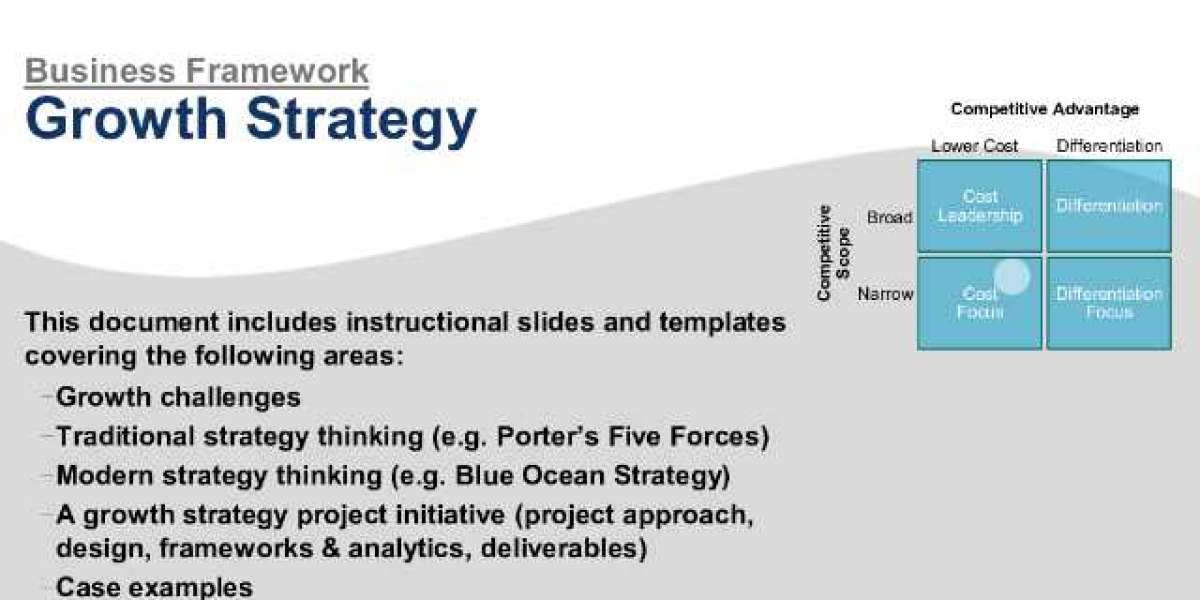Unlocking the secret to sustainable business growth is a goal that every ambitious entrepreneur strives to achieve. It's not just about surviving in today's competitive market; it's about thriving and expanding your reach, influence, and profitability. That's where a well-crafted growth strategy comes into play. A growth strategy is like a roadmap that guides you towards achieving your business objectives while maximizing your potential for success. In this blog post, we'll delve into the world of growth strategies - what they are, why they're vital, different types of strategies available, and most importantly, how to implement them effectively. So fasten your seatbelt as we embark on an exciting journey towards unlocking unprecedented growth opportunities for your business!
What is growth strategy?
Picture your business as a thriving tree, standing tall and strong. Now imagine the growth strategy as the nourishing roots that anchor and support that tree. Just like roots provide stability and enable a tree to flourish, a growth strategy is the foundation upon which successful businesses are built.
At its core, a growth strategy encompasses a set of tactics and initiatives designed to expand your business's reach, customer base, revenue streams, or market share. It involves identifying opportunities for growth within your industry or niche and implementing targeted actions to capitalize on those opportunities.
A growth strategy isn't limited to just one approach; it can take various forms depending on your specific goals and circumstances. Whether it's penetrating new markets, developing new products or services, acquiring competitors, forming strategic partnerships, or expanding globally - the possibilities are endless.
Implementing an effective growth strategy requires careful analysis of market trends and consumer behavior. You need to understand what drives demand in your industry and how you can position yourself strategically to meet that demand better than anyone else.
In essence, a growth strategy is all about being proactive rather than reactive. It means taking calculated risks with clear objectives in mind while constantly adapting to changes in the marketplace. By embracing innovation and seizing opportunities for expansion before they become mainstream trends, you'll be positioning yourself ahead of the curve.
Remember that every business is unique! Your growth strategy should align with your company's values, strengths, resources while considering external factors such as competition and market conditions.
So buckle up! We're now ready to explore some powerful case studies where real-life businesses have successfully implemented their own customized strategies for exponential growth. Get ready to be inspired by their stories of triumph!
Why is growth strategy important?
Why is growth strategy important? It's a question that many businesses ask themselves, and for good reason. A well-executed growth strategy can be the key to long-term success and profitability.
Implementing a growth strategy allows businesses to expand their customer base. By identifying new target markets or finding ways to attract more customers within existing markets, companies can increase their sales and revenue.
Having a growth strategy in place enables businesses to stay competitive in today's fast-paced marketplace. With technology advancing at lightning speed and consumer preferences constantly evolving, it's crucial for companies to adapt and innovate in order to stay relevant.
Furthermore, a solid growth strategy helps organizations maximize their resources and optimize efficiency. By focusing on areas with high potential for growth and reallocating resources accordingly, companies can make the most of their time, money, and manpower.
In addition, implementing a growth strategy fosters innovation within an organization. It encourages employees to think creatively about new products or services that could capture untapped market opportunities or meet emerging customer needs.
Lastly but certainly not least importantly , having a well-defined growth strategy provides clarity of purpose for the entire organization. It sets clear goals and objectives that guide decision-making at all levels of the company. This alignment ensures everyone is working towards common goals which leads to increased productivity and overall success.
To sum up ,growth strategies are essential because they enable businesses to expand their customer base ,stay competitive ,optimize efficiency , foster innovation,and provide clarity of purpose.
The importance of implementing such strategies cannot be overstated as they are often vital factors in determining the long-term success of any business
The different types of growth strategies
The different types of growth strategies are essential for businesses looking to expand and thrive in today's competitive market. These strategies provide a roadmap for achieving long-term success and reaching new heights.
One type of growth strategy is market penetration, which focuses on increasing market share within existing markets. This can be done through aggressive pricing, effective marketing campaigns, or improving customer loyalty. By capturing a larger portion of the market, companies can boost their sales and profitability.
Another approach is product development, where businesses introduce new products or services to cater to the evolving needs of their target audience. This strategy allows companies to tap into untapped markets and attract new customers.
Diversification is yet another growth strategy that involves entering entirely new industries or markets. By expanding into different areas, companies can reduce risks associated with relying solely on one industry or product line.
Additionally, there is strategic alliances and partnerships as a growth strategy where two or more organizations collaborate to leverage each other's strengths and resources. This enables them to reach wider audiences, access new technologies, or enter foreign markets more effectively.
Understanding the different types of growth strategies is crucial for businesses aiming to create sustainable expansion plans tailored to their unique goals and circumstances
How to implement a growth strategy
Implementing a growth strategy can be a game-changer for businesses looking to expand and thrive in today's competitive market. But how exactly do you go about implementing one? Here are some key steps to get you started.
It's important to have a clear understanding of your goals and objectives. What do you want to achieve with your growth strategy? Are you aiming for increased sales, new market penetration, or diversification of your product offerings? Defining these goals will help guide your implementation plan.
Next, conduct a thorough analysis of your current business operations. Identify any areas that may need improvement or optimization in order to support future growth. This could include streamlining processes, investing in technology upgrades, or enhancing customer service capabilities.
Once you've identified areas for improvement, it's time to develop an action plan. Break down the steps needed to implement each aspect of your growth strategy and assign responsibilities accordingly. Set realistic timelines and milestones to track progress along the way.
Communication is key throughout the implementation process. Ensure that all stakeholders are aware of the growth strategy and their roles in executing it. Regularly update team members on progress and address any challenges or roadblocks that may arise.
Monitor and evaluate the effectiveness of your growth strategy as it unfolds. Keep track of key metrics such as revenue growth, customer acquisition rates, and market share expansion. Adjust your approach as necessary based on data-driven insights.
By following these steps and staying committed to continuous improvement, you can successfully implement a growth strategy that propels your business forward in today's dynamic marketplace
Growth strategy case studies
Growth strategy case studies offer valuable insights into how companies have successfully implemented growth strategies to drive expansion and achieve their business goals. These real-life examples provide concrete evidence of the effectiveness of various growth strategies in different industries.
One notable case study is that of Airbnb, which disrupted the traditional hospitality industry by leveraging a platform-based business model. By connecting homeowners with travelers, Airbnb was able to rapidly expand its network and gain a significant market share. This growth strategy allowed them to overcome initial challenges and establish themselves as a global leader in the sharing economy.
Another compelling example is Amazon's strategic acquisition of Whole Foods Market. Through this bold move, Amazon was able to diversify its product offering and gain access to new customers through physical retail locations. This growth strategy not only strengthened Amazon's position in the e-commerce space but also enabled them to tap into the lucrative grocery market.
Similarly, Uber utilized a disruptive innovation strategy to revolutionize transportation services worldwide. By capitalizing on mobile technology and creating an intuitive app-based platform, Uber transformed the way people commute. This innovative approach fueled rapid growth for Uber, making it one of the most valuable start-ups in recent history.
These case studies highlight the importance of selecting the right growth strategy based on industry dynamics and company capabilities. Whether it involves entering new markets, developing new products or services, or adopting innovative technologies, implementing an effective growth strategy requires careful analysis and strategic decision-making.
By studying these successful cases and understanding their underlying principles, businesses can learn valuable lessons about how to implement growth strategies that are tailored to their specific needs and objectives. However, it is important to note that what works for one company may not necessarily work for another due to differences in resources, competitive landscape, and customer preferences.
In conclusion,
growth strategy case studies serve as invaluable sources of inspiration for businesses looking to expand their horizons. They provide practical examples of how companies have navigated challenges while achieving remarkable success through well-executed growth strategies. By studying these cases, businesses can gain valuable insights and
Conclusion
Conclusion
In today's competitive business landscape, implementing a growth strategy is crucial for the long-term success and sustainability of any organization. A well thought out and carefully executed growth strategy can help businesses expand their market reach, increase profitability, and stay ahead of the competition.
Throughout this article, we have explored what exactly a growth strategy is and why it is important. We have also discussed the different types of growth strategies that businesses can adopt based on their goals and resources. From market penetration to product development to diversification, there are various avenues to explore when planning for growth.
Moreover, we have delved into how businesses can implement a growth strategy effectively. This involves conducting thorough market research, setting clear objectives, identifying target markets or customer segments, developing innovative products or services, leveraging technology and digital marketing channels, building strong partnerships or alliances with other organizations in related industries - just to name a few.
To illustrate the practical application of these strategies in real-world scenarios, we have examined some compelling case studies. These examples highlight how companies such as Amazon and Airbnb strategically implemented growth initiatives to revolutionize their respective industries.
As you embark on your own journey towards achieving sustainable growth for your business, remember that there is no one-size-fits-all approach. Every organization has unique challenges and opportunities. It's essential to analyze your specific circumstances carefully before determining which combination of strategies will work best for you.
In conclusion (without actually saying "in conclusion"), implementing a successful growth strategy requires careful planning, adaptability to changing market dynamics,
and continuous evaluation of outcomes against set goals. By focusing on innovation,
customer-centricity,
and strategic decision-making,
businesses can position themselves at the forefront of industry trends
and drive long-term success.
So don't wait any longer -
start crafting your tailored growth strategy today!
Remember: Growth doesn't happen by chance; it happens by design!



